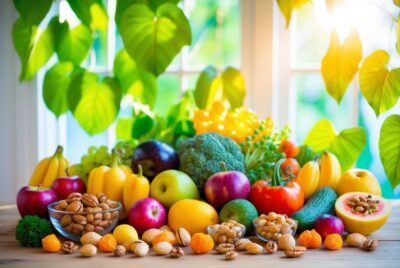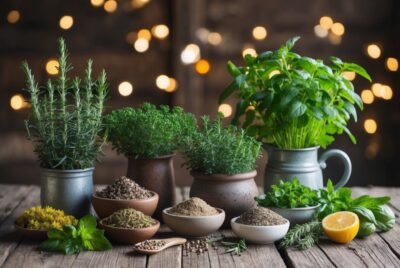Juicing for Gut Health: Revitalize Your Gut
*We may earn a commission for purchases made using our links. Please see our disclosure to learn more.
Juicing for Gut Health: Optimize Your Digestive Well-being
Juicing has become a key trend in the pursuit of wellness, particularly for its potential benefits for gut health. When I talk about juicing, I’m referring to the process of extracting the natural liquids, vitamins, and minerals from raw fruits and vegetables. This practice allows for an efficient way to consume a wide array of nutrients readily absorbed by the body, which may contribute positively to the digestive system. A well-functioning gut is crucial for overall well-being, playing a significant role in digestion, immunity, and even mood regulation.

Incorporating a variety of juices into my diet has given me a way to support my digestive health. The fresh produce used in juicing typically includes compounds that promote a balanced intestinal flora and soothe the digestive tract. Certain ingredients are known for their anti-inflammatory properties, which can help reduce gut inflammation, often a precursor to more serious digestive issues.
As someone who pays close attention to my body’s responses, I’ve observed how different juices can impact my system. Vegetables like cucumber and leafy greens, along with fruits such as apples, pineapples, and citrus, have become staples in my juicing routine. They not only provide essential vitamins and minerals but also hydrate and assist in flushing out toxins, supporting my gut health in a comprehensive manner.
Understanding Gut Health

In my exploration of gut health, I focus on its intricate connection with diet and the clear signs that may indicate gut imbalance.
The Role of Diet in Gut Function
My diet plays a central role in the functioning of my gut. It directly affects the composition of gut bacteria, which are crucial for effective digestion and overall health. Consuming a varied diet rich in fiber helps promote beneficial bacteria growth. These bacteria aid in breaking down food, absorbing nutrients, and synthesizing certain vitamins.
- Probiotics are living microorganisms found in fermented foods like yogurt and sauerkraut. Including them in my meals introduces beneficial bacteria to my gut.
- Prebiotics, on the other hand, are dietary fibers that feed the good bacteria already present. Foods high in prebiotics include garlic, onions, and bananas.
Signs of an Unhealthy Gut
I stay vigilant for symptoms that might indicate an unhealthy gut. Here are some signs I look for:
- Digestive issues: Frequent bloating, gas, constipation, diarrhea, and heartburn can all be signs that my gut bacteria are out of balance.
- Food intolerances: These are often the result of difficulty digesting certain foods, a possible sign of poor gut health.
I understand that maintaining a healthy gut is key for my overall well-being, including digestion and nutrient absorption. By paying attention to my body’s responses to different foods and incorporating a variety of probiotics and prebiotics into my diet, I can support my digestive health.
Basics of Juicing

In my experience with juicing, it’s an effective way to consume the nutrients from fruits and vegetables. This section will cover how to choose the right ingredients for maximum health benefits and the differences between juicing and blending.
Choosing the Right Ingredients
When I select ingredients for juicing, I focus on a variety of vegetables and fruits to ensure I’m getting a broad spectrum of vitamins and minerals. Here’s my approach:
- Vegetables: I choose leafy greens like spinach and kale for their high vitamin K content. I also include celery for its mineral content, and beets for their antioxidants and iron.
- Fruits: Apples and pears are my go-to for a natural sweetness and additional fiber. Berries offer antioxidants, while citrus fruits like oranges and grapefruits provide a good dose of vitamin C.
I always make sure to wash my produce thoroughly to remove any pesticides and to peel or remove any inedible or bitter parts.
Juicing vs Blending
Understanding the difference between juicing and blending is important for my health routine:
- Juicing: This process extracts water and nutrients from produce and leaves behind the fiber. Juicing can offer a concentrated dose of vitamins and minerals and is easier for the body to absorb. However, the lack of fiber means it’s less filling.
- Blending: Blending pulverizes the entire fruit or vegetable, keeping the fiber intact. This can help with digestion and provide a feeling of fullness. While blending does include fiber, it can result in a less concentrated nutrient intake compared to juicing.
In both juicing and blending, I’m mindful of the sugar content of my ingredients, especially fruits, to maintain a balanced diet.
Benefits of Juicing for the Gut

I understand that maintaining gut health is crucial for overall well-being, and juicing can be a beneficial part of that process. I’ll detail how it promotes the production of digestive enzymes and enhances the absorption of nutrients.
Enhancing Digestive Enzymes
Juicing aids in increasing digestive enzymes which are essential for breaking down food and extracting nutrients. For example, bromelain, an enzyme found in pineapples, is known for its help in digesting proteins and reducing inflammation in the gut. By juicing fruits and vegetables high in these enzymes, I can provide my body with a natural boost to my digestive system.
Improving Nutrient Absorption
Through my research, I’ve learned that the process of juicing breaks down plant cell walls, resulting in a liquid that is rich in vitamins, minerals, and phytonutrients. This form allows for easier and faster absorption of nutrients by my gut compared to consuming whole fruits and vegetables. Juicing can particularly improve the uptake of certain antioxidants, which are vital in combatting inflammation and supporting detoxification processes in the gut.
Preparation Techniques and Recipes

When I craft juices for gut health, I focus on ingredient balance and proper techniques to maximize the health benefits. Below, you’ll find my approaches and specific recipes that support digestive wellness.
Creating a Balanced Juice
I always start with a base ingredient known for its beneficial properties like apples for their pectin or carrots for beta-carotene. Then, I add greens such as spinach or kale for additional nutrients. To enhance flavor and boost the digestive benefits, I include a bit of ginger or mint. Finally, lemon juice provides a refreshing tang and can help preserve the juice.
Essential Components for Balance:
- Base: Carrots, apples
- Greens: Spinach, kale
- Flavor and Function: Ginger, mint, lemon
Example of a Balanced Juice Mix:
- 2 large carrots
- 1 green apple
- A handful of spinach
- 1-inch piece of ginger
- A few leaves of mint
- Juice from 1/2 a lemon
Juicing Recipes for Optimal Gut Health
For optimal gut health, my recipes focus on ingredients that are known to support the digestive system. The right mix can reduce inflammation and support the gut lining.
- Anti-Inflammatory Green Juice
- 1 cup pineapple
- 1 cucumber
- A small piece of ginger
- Juice of 1/2 lemon
- A few mint leaves
- Classic Beet Juice
- 1 medium beet
- 2 carrots
- 1 apple
- 1-inch ginger root
Instructions for both recipes are straightforward. Begin by washing and preparing the fruits and vegetables, peeling if necessary. Cut them into sizes that fit your juicer. Alternate hard and soft ingredients to get the most juice out. For tough greens, I roll them up tightly before juicing. Serve immediately to enjoy the full spectrum of nutrients.
Making smoothies is similar, but unlike juicing, it maintains the fiber which is also excellent for gut health. For a smoothie, simply blend the ingredients instead of juicing them, adding water or ice as needed for consistency.
Lifestyle Considerations

When I focus on gut health, I recognize the importance of integrating juicing with a well-rounded diet and understanding its overall health implications. This ensures optimal nutrition without over-reliance on juices.
Incorporating Juices into a Balanced Diet
I always aim for moderation when incorporating juices into my diet. Juices should complement, not replace, whole foods. I make sure that my diet remains rich in fibers, proteins, and healthy fats and that juices serve primarily as a source of additional vitamins and minerals. For weight loss or managing conditions like IBS and bloating, I watch my fruit juice intake due to its high sugar content and opt for more vegetable-based concoctions with anti-inflammatory properties.
- Moderation is key: Do not substitute meals with juice; use it as a supplement.
- Diverse Nutrients: Ensure a variety of foods to cover all nutritional needs.
Understanding the Impact of Juicing on Overall Health
Juicing has its place in my stress management and anti-inflammatory routines, but I don’t let it overshadow other health aspects. Adequate hydration, exercise, and stress reduction are vital. While some juices may alleviate constipation due to their fluid content, they are low in fiber compared to whole fruits and vegetables. Hence, I balance juice consumption with high-fiber foods to maintain smooth digestive functioning.
- Holistic Approach: Combine juicing with other healthy lifestyle practices.
- Nutrition Balance: Counterbalance the low fiber in juices with whole fruits and vegetables.
Frequently Asked Questions
In this section, I address some of the most common inquiries regarding juicing for gut health. These questions touch on recipes, cleanses, weight loss, and specific ingredients beneficial for the gut.
1. What are some effective juicing recipes for improving gut health?
My research indicates that ingredients such as pineapple, ginger, and leafy greens are especially good for gut health. A simple recipe might involve juicing ripe pineapple with fresh ginger root—both recognized for their digestive benefits.
2. How can a 3-day juice cleanse benefit gut health?
A short 3-day juice cleanse can give the digestive system a break from processing solids. It’s a period where the gut gets to rest while still absorbing essential vitamins and nutrients from the juices.
3. Is there a correlation between juicing and weight loss in the context of gut health?
While juicing in itself isn’t a silver bullet for weight loss, incorporating low-calorie, nutrient-dense juices in place of higher-calorie meals can contribute to a calorie deficit. This may lead to weight loss, and a healthy gut can improve metabolism efficiency.
4. Which ingredients are known to reduce gut inflammation when juicing?
Ingredients like turmeric, ginger, and green leafy vegetables are known for their anti-inflammatory properties. Juices made with these ingredients can help reduce gut inflammation.
5. What are the best juice combinations for promoting overall digestive wellness?
Combining a variety of fruits and veggies that are high in antioxidants, vitamins, and fibers is best for digestive wellness. Some of these combinations include carrot, apple, and ginger or beet with carrot and cucumber, providing a balance of taste and health benefits.




